![]()
![]()
![]()
Use LEFT and RIGHT arrow keys to navigate between flashcards;
Use UP and DOWN arrow keys to flip the card;
H to show hint;
A reads text to speech;
32 Cards in this Set
- Front
- Back
|
The Six Functions of the Skeletal System |
1. Support 2. Protection 3. Movement 4. Mineral Storage 5. Blood Cell Production 6. Storage of Energy |
|
|
The Six Functions of the Skeletal System
Support |
Support: provide a framework for attachment of soft connective tissue, such as muscles. |
|
|
The Six Functions of the Skeletal System
Protection |
Protection: protect the internal organs. |
|
|
The Six Functions of the Skeletal System
Movement |
Movement: when muscles contract they pull on bones and produce movement. |
|
|
The Six Functions of the Skeletal System
Mineral Storage |
Mineral Storage: store calcium and phosphorus, which are released when needed. |
|
|
The Classification of Bones |
Almost all bones can be classified into one of four main types, depending on their shape: long, short, flat and irregular. |
|
|
The Six Functions of the Skeletal System
Blood Cell Production |
Blood Cell Production: most blood cell formation occurs within the red bone marrow. |
|
|
The Six Functions of the Skeletal System
Storage of Energy |
Storage of Energy: yellow bone marrow is a stored source of lipids in the bones. |
|
|
Long Bones |
The classification of a long bone includes having a body which is longer than it is wide.
Examples: femur, tibia, fibula, metatarsals, humerus, radius, ulna, metacarpals and phalanges. |
|
|
Short Bones |
Short bones are defined as being approximately as wide as they are long and have a primary function of providing support and stability with little movement.
Examples: tarsals and carpals. |
|
|
Flat Bones |
Flat bones are strong, flat plates of bone with the main function of providing protection to the bodies vital organs and being a base for muscular attachment.
Examples: sternum, scapula and cranium. |
|
|
Irregular Bones |
These are bones in the body which do not fall into any other category, due to their non-uniform shape.
Examples: vertebrae and facial portion. |
|
|
How many bones are in the human skeleton? |
206 named bones in the human skeleton. |
|
|
The Axial Skeleton |
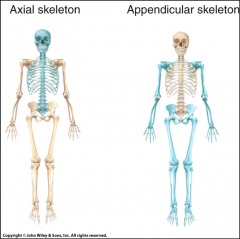
Support |
|
|
The Appendicular Skeleton |

Movement |
|
|
The Classification of Joints |
Fibrous Cartilaginous Synovial |
|
|
The Classification of Joints
Fibrous |
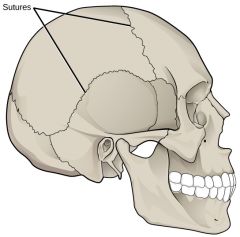
Fibrous: the bone have no joint cavity, and they are held together by strong connective tissue. |
|
|
The Classification of Joints
Cartilaginous |
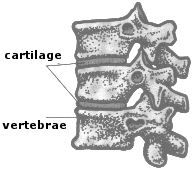
Cartilaginous: the bones have no joint cavity, and the are held together by cartilage. |
|
|
The Classification of Joints
Synovial |
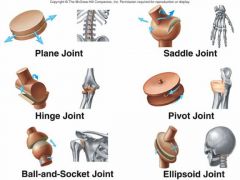
Synovial: the bones have a joint cavity, and they are held together by ligaments and separated by synovial fluid in the joint cavity. |
|
|
Structure and Function of Synovial Joints
Articular Capsule |
A capsule that encloses the joint cavity. |
|
|
Structure and Function of Synovial Joints
Articular Cartilage |
A connective tissue covering the surface of articulating bones. |
|
|
Structure and Function of Synovial Joints
Synovial Fluid |
A secretion that lubricates and nourishes the articular cartilage. |
|
|
Structure and Function of Synovial Joints
Bursa |
A small sac containing synovial fluid, located at friction sites between bones and tendons. |
|
|
Structure and Function of Synovial Joints
Tendons |
Fibrous cords dense connective tissue that attaches muscle to bone. |
|
|
Structure and Function of Synovial Joints
Ligaments |
Dense connective tissue that attaches bone to bone. |
|
|
The Vertebral Column |
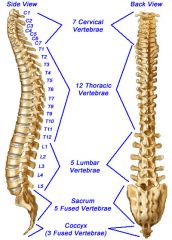
Consists of 24 moveable vertebrae in three sections: 7 Cervical 12 Thoracic 5 Lumbar
with 5 fused bones in the sacrum and 4 fused bones to form the coccyx. |
|
|
Synovial Joints
Gliding Joint |
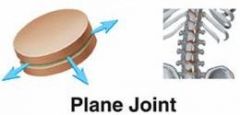
The gliding joint allows gliding between two flat surfaces. Side-to-Side or Back-and-Forth movement. Examples: Carpals and Tarsals |
|
|
Synovial Joints
Hinge Joint |
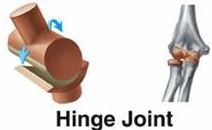
The hinge joint allows movement in only one direction. Examples: Elbow and Knee
|
|
|
Synovial Joints
Pivot Joint |
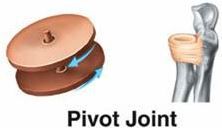
This joint allows a rotation movement. Examples:
|
|
|
Synovial Joints
Ellipsoid or Condyloid Joint |

Movement occur in two planes. Examples: |
|
|
Synovial Joints
Saddle Joint |
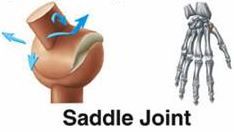
|
|
|
Synovial Joints
Ball and Socket Joint |
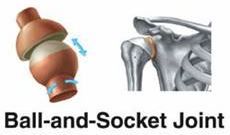
This joint allows a wide range of movement which is made possible by a round-headed bone fitting into a cup-shaped socket. Examples: Hip and Shoulder |

